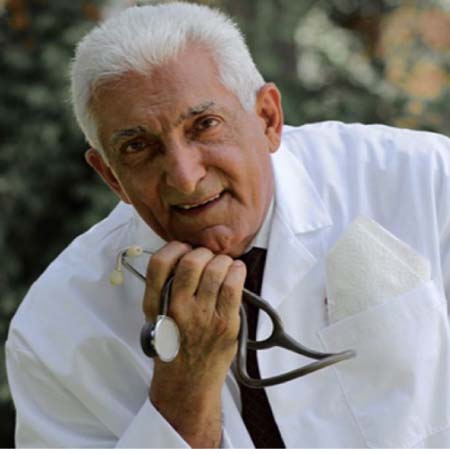
Understanding Tuberculosis -- the Basics
November 12 commemorates the day in 1882 when Dr Robert Koch astounded the scientific community by announcing to a small group of scientists at the University of Berlin’s Institute of Hygiene that he had discovered the cause of tuberculosis, the TB bacillus According to Koch’s colleague, Paul Ehrlich, “At this memorable session, Koch appeared before the public with an announcement which marked a turning-point in the story of a virulent human infectious disease. In clear, simple words Koch explained the etiology of tuberculosis with convincing force, presenting many of his microscope slides and other pieces of evidence.” At the time of Koch’s announcement in Berlin, TB was raging through Europe and the Americas, causing the death of one out of every seven people. Koch’s discovery opened the way toward diagnosing and curing tuberculosis.
What Is Tuberculosis
Tuberculosis, commonly known as TB, is a bacterial infection that can spread through the lymph nodes and bloodstream to any organ in your body. It is most often found in the lungs. Most people who are exposed to TB never develop symptoms because the bacteria can live in an inactive form in the body. But if the immune system weakens, such as in people with HIV or elderly adults, TB bacteria can become active. In their active state, TB bacteria cause death of tissue in the organs they infect. Active TB disease can be fatal if left untreated.
Because the bacteria that cause tuberculosis are transmitted through the air, the disease can be contagious. Infection is most likely to occur if you are exposed to someone with TB on a day-to-day basis, such as by living or working in close quarters with someone who has the active disease. Even then, because the bacteria generally stay latent (inactive) after they invade the body, only a small number of people infected with TB will ever have the active disease. The remaining will have what’s called latent TB infection -- they show no signs of infection and won’t be able to spread the disease to others, unless their disease becomes active.
Because these latent infections can eventually become active, even people without symptoms should receive medical treatment. Medication can help get rid of the inactive bacteria before they become active.
TB was once a widespread disease. It was virtually wiped out with the help of antibiotics developed in the 1950s, but the disease has resurfaced in potent new forms -- multidrug-resistant TB and extensively drug-resistant TB. Today, these new and dangerous forms of the disease -- resistant to some of the commonly used drug treatments -- have created a public health crisis in many large cities worldwide. If you have TB -- in its active or latent state -- you must seek medical treatment.
World Tuberculosis Day, falling on March 24 each year, is designed to build public awareness about the global epidemic of tuberculosis and efforts to eliminate the disease. Today tuberculosis causes the deaths of about 1.7 million people each year, mostly in the Third World.
World Tuberculosis Day 2015
On the occasion of World TB Day 2010, the International Committee of the Red Cross declared that attempts to stem the spread of tuberculosis across the globe are likely to fall well short of what is needed unless authorities in affected countries significantly increase their efforts to stop the deadly disease from breeding inside prisons. As a result of overcrowding and poor nutrition, TB rates in many prisons are 10 to 40 times higher than in the general public. The ICRC has been fighting TB in prisons in the Caucasus region, Central Asia, Latin America, Asia Pacific and Africa for more than a decade, either directly or by supporting local programmers.
Tuberculosis or TB is a common, and in many cases lethal, infectious disease, usually cause by bacteria.Tuberculosis typically attacks the lungs, but can also affect other parts of the body. It is spread through the air when people who have an active TB infection cough, sneeze, or otherwise transmit their saliva through the air.Most infectionsdose not show symptoms and is latent, but about one in ten latent infections eventually progresses to active disease which, if left untreated, kills more than 50% of those so infected.
The classic symptoms of active TB infection are a chronic (long-standing) cough with blood-tinged sputum, fever, night sweats, and weight loss (the latter giving rise to the formerly prevalent term “consumption”). Infection of other organs causes a wide range of symptoms. Diagnosis of active TB relies on radiology (commonly chest X-rays), as well as microscopic examination and microbiological culture of body fluids.
Diagnosis of latent TB relies on the tuberculin skin test (TST) and/or blood tests. Treatment is difficult and requires administration of multiple antibiotics over a long period of time. Social contacts are also screened and treated if necessary. Antibiotic is a growing problem in multiple drug-resistant tuberculosis (MDR-TB) infections. Prevention relies on screening programs and vaccination with the vaccine.
One third of the world’s population is thought to have been infected with M. Tuberculosis, with new infections occurring at a rate of about one per second. In 2007, there were an estimated 13.7 million chronic active cases globally, while in 2010, there were an estimated 8.8 million new cases and 1.5 million associated deaths, mostly occurring in developing countries. The absolute number of tuberculosis cases has been decreasing since 2006, and new cases have decreased since 2002. The distribution of tuberculosis is not uniform across the globe; about 80% of the population in many Asian and African countries test positive in tuberculin tests, while only 5–10% of the United States population tests positive. More people in the developing world contract tuberculosis because of compromised immunity, largely due to high rates of HIV infection and the corresponding development of AIDS
HOW DANGEROUS IS TUBERCULOSIS (TB) DISEASE
We find this lethal disease tuberculosis (TB) also in the Gambia and it killing these people who have not been diagnosed and not been treated due to their luck of awareness of the disease and possible their negligence not to visit any of the health facilities throughout the country. Diagnose and treatment of tuberculosis is one of the highest Health care priorities of the Gambian Health Ministry with sufficient facilities and specialist in the major Government Hospitals including the EFSTH, MRC and number of Health Clinics throughout the country.
Signs and symptoms
The main symptoms of variants and stages of tuberculosis are given,] with many symptoms overlapping with other variants, while others are more (but not entirely) specific for certain variants. Multiple variants may be present simultaneously.
About 5–10% of those without HIV, infected with tuberculosis, develop active disease during their lifetimes. In contrast, 30% of those co infected with HIV develop active disease. Tuberculosis may infect any part of the body, but most commonly occurs in the lungs (known as pulmonary tuberculosis)General signs and symptoms include fever, chills, night sweats, loss of appetite, weight loss, and fatigue, and significant finger clubbing may also occur.
Pulmonary (Lungs)
If a tuberculosis infection does become active, it most commonly involves the lungs (in about 90% of cases). Symptoms may include chest pain and a prolonged cough producing sputum. About 25% of people may not have any symptoms (i.e. they remain (“without symptoms”).Occasionally, people may cough up blood in small amounts, and in very rare cases, the infection may erode into the pulmonary artery, resulting in massive bleeding. Tuberculosis may become a chronic illness and cause extensive scarring in the upper lobes of the lungs.
Extra pulmonary (out site the lungs)
In 15–20% of active cases, the infection spreads outside the respiratory organs, causing other kinds of TB. These are collectively denoted as “extra pulmonary tuberculosis”. Extra pulmonary TB occurs more commonly in immune suppressed persons and young children. In those with HIV, this occurs in more than 50% of cases. Notable extra pulmonary infection sites include the central nervous system (in tuberculosis meningitis), the lymphatic system (in scrofula of the neck), the genital system , and the bones and joints , among others. When it spreads to the bones, it is also known as “osseous tuberculosis”
TUBERCULOSIS Causes
The primary cause of TB, ‘’Mycobacterium tuberculosis’’, is a small aerobic non-motile bacillus. It divides every 16 to 20 hours, an extremely slow rate compared with other bacteria, which usually divide in less than an hour..
Risk factors
Persons with chronic kidney failure who are on haemodialysis also have an increased risk: 10—25 times greater than the general population. Persons with diabetes mellitus have a risk for developing active TB that is two to four times greater than persons without diabetes mellitus, and this risk is likely greater in persons with insulin-dependent or poorly controlled diabetes. Low body weight is associated with risk of tuberculosis as well. Patients with diabetes millet are at increased risk of contracting tuberculosis, and they have a poorer response to treatment, possibly due to poorer drug absorption
Other conditions that increase risk include IV drug abuse; recent TB infection or a history of inadequately treated TB; chest X-ray suggestive of previous TB, (30-40% of AIDS patients in the world also have TB), such as leukaemia and Hodgkin’s disease; end-stage kidney disease; intestinal bypass; chronic absorption syndromes; vitamin D deficiency; and low body weight.
Transmission
When people with active pulmonary TB cough, sneeze, speak, sing, or spit, they expel infectious aerosol droplets 0.5 to 5.0 µm in diameter. A single sneeze can release up to 40,000 droplets. Each one of these droplets may transmit the disease, since the infectious dose of tuberculosis is very low (the inhalation of fewer than 10 bacteria may cause an infection).
People with prolonged, frequent, or close contact with people with TB are at particularly high risk of becoming infected, with an estimated 22% infection rate.
A person with active but untreated tuberculosis may infect 10–15 (or more) other people per year. Transmission should only occur from people with active TB - those with latent infection are not thought to be contagious. The probability of transmission from one person to another depends upon several factors, including the number of infectious droplets expelled by the carrier, the effectiveness of ventilation, the duration of exposure, the virulence of the M. tuberculosis strain, the level of immunity in the uninfected person, and others.
Diagnosis
Active tuberculosis
A chest X-ray and multiple sputum cultures for acid-fast bacilli are typically part of the initial evaluation. A definitive diagnosis of TB is made by identifying M. tuberculosis in a clinical sample (e.g. sputum, pus, or a tissue biopsy). However, the difficult culture process for this slow-growing organism can take two to six weeks for blood or sputum culture. Thus, treatment is often begun before cultures are confirmed.[58]
Prevention
Vaccines
(BCG) is the most widely used vaccine worldwide, with more than 90% of all children being vaccinated. However, the immunity it induces decreases after about ten years. Tuberculosis prevention and control efforts primarily rely on the vaccination of infants and the detection and appropriate treatment of active cases. The World Health Organization has achieved some success including in the Gambia with improved treatment regimens.
In the Gambia you can get further information about diagnose and treatment from EFSTH, MRC and number of other Government’s Hospitals and Health clinics, or e mail azadehhassan@yahoo.co.uk or text only to 77744693774469 during working days from 3-6pm.
Author DR Azadeh Senior Lecturer at the University of the Gambia and Senior Consultant in Obstetrics & Gynaecology. Clinical Director Medicare Health Services


